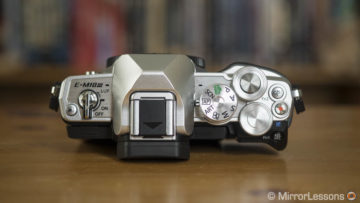The OM-D E-M10 mark III arrives two years after its popular predecessor, the E-M10 II. It brings 4K video, a new image processor, a re-designed menu interface that makes the camera more beginner-friendly and other minor improvements. However the process of simplifying the camera has eliminated a number of useful settings along the way as we’ll discover below.
Main Specs
- Sensor: 16 MP 4/3 Live Mos
- Lens system: Micro Four Thirds
- Weatherproof: No
- Internal Stabilisation: Yes (5-axis)
- Autofocus: contrast detection with 121 points
- Continuous shooting: 8.6fps (AF-S), 4.8fps (AF-C), 11fps (AF-S) with electronic shutter CHECK
- ISO Sensitivity: 200 – 25600 ISO (Pull 100)
- Shutter Speeds: 1/4000 to 60 seconds, 1/16000s with electronic shutter
- Viewfinder: 2,360K dots, approx. 100% FOV coverage and 1.23x (0.62x) magnification
- Rear monitor: Tilting 3″ touch sensitive LCD (1,040K dots)
- Movie recording: 4K up to 30fps, Full HD up to 60fps, HD up to 120fps
- Built-in Flash: Yes
- Extra Features: WiFi, Timelapse, HDR, Multiple exposure, Live Time, Live Composite, Focus Stacking, AE Bracketing, Keystone compensation,
- Dimensions: 121.5 x 83.6 x 49.5mm
- Weight: 410g (including battery and memory card)
- Firmware version: 1.0
Video Review
Below you can watch our video review in the Fast 5-minute format where we summarise the pros and cons of the Olympus camera.
Summary of our findings
- Design and ease of use: The camera has a beautiful design and is nice to use thanks to the precise dials and buttons. The grip is larger which improves the experience with larger lenses (the optional landscape grip is no longer necessary) and the top and bottom parts are now all plastic rather than metal. The menu system has a new design (the same as the flagship E-M1 II) and has been reduced to the essentials, which means it is much quicker to navigate and learn. The EVF offers excellent brightness and clarity while the LCD screen gives you touch sensitivity with useful functions such as the AF Targeting Pad (the possiblity to move the focus point while composing with the EVF).
- Image quality: the sensor is the same as its predecessor – the E-M10 mark II – so don’t expect any improvements. The only minor thing I noticed is noise reduction at high ISOs with SOOC JPGs: the new processor gives a cleaner result when NR is Off but less detail at the highest value.
- Video quality: because the camera uses the same image processor as the E-M1 II – the TruePic VIII – the E-M10 mark III can record 4K video up to 30fps with a maximum bitrate of 102Mbps. The latter is variable however and the camera tends to stay below 50Mbps most of the time. That being said I haven’t noticed a significant drop in quality: the footage is reasonably sharp and despite not having dedicated video profiles, you get lovely colours with the Natural Picture Mode. Rolling shutter is well contained but low light performance is more limited as noise becomes invasive past 3200 ISO. The quality has improved in 1080p in comparison to the E-M10 II and you can get slow motion at 120fps in 720p, although the quality is much worse. There’s no mic input.
- Image stabilisation: despite not integrating the most advanced tech the brand has to offer, the E-M10 III does well – better than most of its competitors in this department in fact. Sharp images at 1/2 or 1/4s are possible and the camera performs very well for video too.
- Autofocus and speed: the updated contrast detection system with 121 points doesn’t bring any substantial advantage over the predecessor. The AF speed and accuracy remains more or less the same. It does great with static subjects but struggles with fast moving subjects. The same reasoning applies for video although keeping the shutter button half pressed in this case can help when face detection is activated for example. Face and Eye detection deliver good performance overall but can lack precision. The AF cluster mode where the camera uses multiple focus points sadly only works in S-AF. The burst speeds are ever so slightly faster than before but the compatibility with UHS-II cards help with the buffer memory.
- Downgrades: as expected the new camera comes with lots of extra features such as Wifi, Time-lapse, Live Composite, Focus Bracketing, etc. However a lot of these features are accessible via the Advanced Photo mode only, which doesn’t offer manual exposure control. Even other options like the electronic shutter can’t be activated in M mode. Other features have disappeared like the wireless RC Flash mode, and there are fewer options and far less customisation (2 functions buttons only and no Myset modes).
Conclusion
A beginner looking for his or her first camera will find lots of things to like about the E-M10 mark III. It has a gorgeous design, is the most straightforward Olympus camera to use, and provides sufficient image and video quality as well as lots of extra features to keep you busy shooting.
However if you already have experience with OM-D or Pen cameras, the omission of useful features and some manual controls may prove a disappointment.
Sample images














